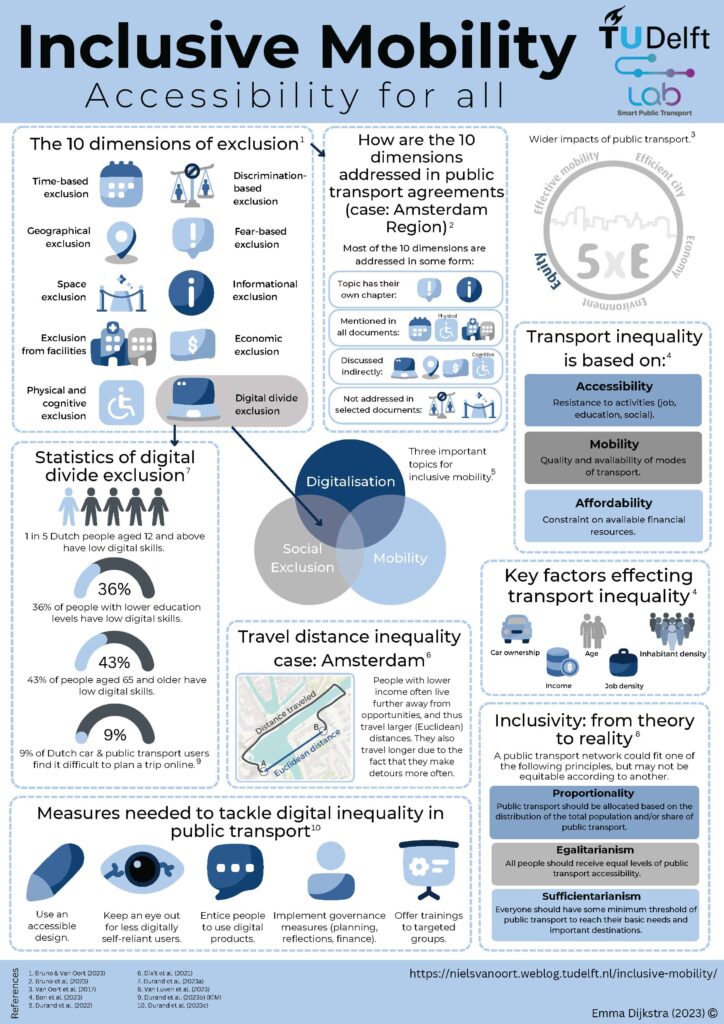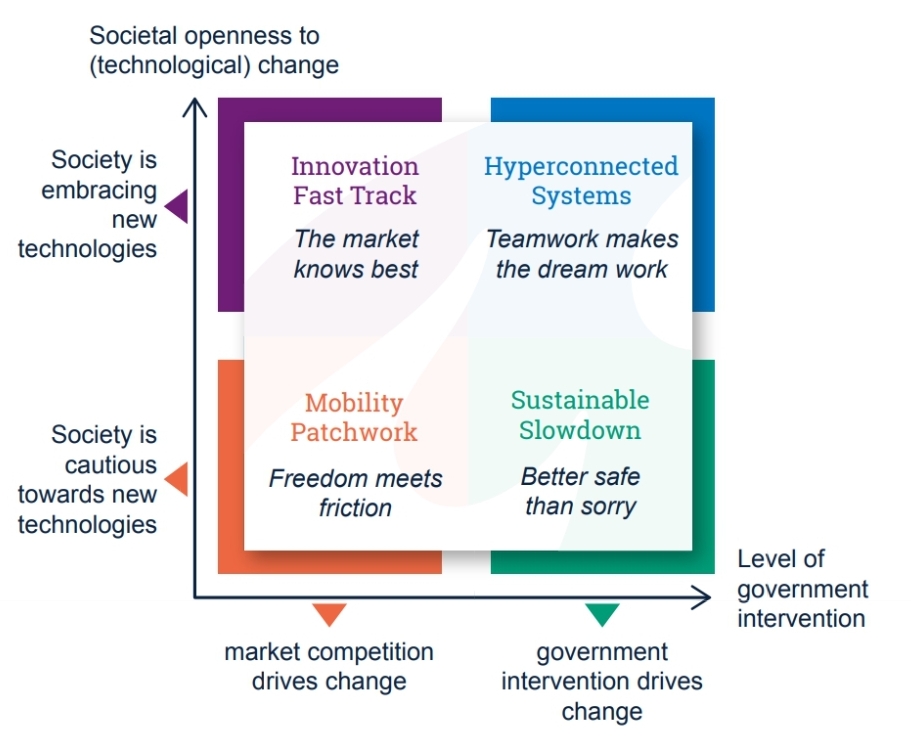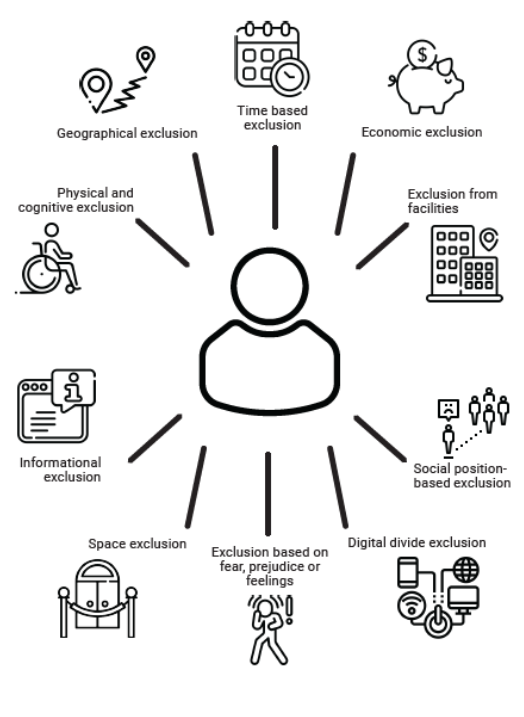Posts tagged inclusive mobility
Inclusive mobility
Learn more about our research and findings regarding inclusive mobility:

Download the infographic HERE
References
- Bruno, M., and N. Van Oort (2023) The ten dimensions of transport related social exclusion, position paper
- Bruno, M., Kouwenberg, M., & van Oort, N. (2024). Evaluating How Transportation Policy Addresses Transport Related Social Exclusion: A Novel Method Applied to the Amsterdam Transport Region. Transportation Research Interdisciplinary Perspectives, Volume 26.
- Van Oort, N., R.A.J. vd Bijl, F.C.A. Verhoof (2017), The wider benefits of high quality public transport for cities, European Transport Conference, Barcelona.
- Bon, T., Bruno, M., & van Oort, N. (2025). Three-dimensional transport poverty and its socio-demographic and urban density predictors: Spatial regression analyses of neighborhoods in the Amsterdam metropolitan area. Transportation Research Interdisciplinary Perspectives.
- Durand, A., Zijlstra, T., van Oort, N., Hoogendoorn-Lanser, S., & Hoogendoorn, S. (2022) Access denied? Digital inequality in transport services, Transport Reviews, 42:1, 32-57
- Dixit M., Chowdhury S., Cats O., Brands T., van Oort N. and Hoogendoorn S. (2021). Examining circuity of urban transit networks from an equity perspective, Journal of Transport Geography, Volume 91, 102980.
- Durand, A., Zijlstra, T., Hamersma, M., van Oort, N., Hoogendoorn-Lanser, S., & Hoogendoorn, S. (2023). “Who can I ask for help?”: Mechanisms behind digital inequality in public transport. Cities, 137, 104335
- Van Luven, M., N. van Oort, O. Cats, M. Bruno, M. Kouwenberg (2023), How to achieve an equitable distribution of accessibility by evaluating and modifying public transport networks: a comparison of accessibility distribution principles in the Netherlands, European Transport Conference, Milano.
- Durand, A., Hamersma, M., Rienstra, S. (2023). Use and perceived effects of digital travel information for car and public transport travel. Brochure. The Hague: Netherlands Institute for Transport Policy Analysis (KiM).
- Durand, A., Zijlstra, T., Hamersma, M., van Oort, N., Hoogendoorn-Lanser, S., & Hoogendoorn, S. (2023). Fostering an inclusive public transport system in the digital era: an interdisciplinary approach. Transportation Research Interdisciplinary Perspectives, Volume 22, 100968.
Toegankelijk OV
Voor veel mensen met een beperking is het openbaar vervoer de enige manier om (zelfstandig) te reizen. Vorig jaar concludeerde de Verenigde Naties echter dat Nederland te weinig doet om de toegankelijkheid van het openbaar vervoer voor deze groep te waarborgen. Reden voor TU Delft student Jelmer Nederhof om hier onderzoek naar te doen. “Ik wilde vooral onderzoeken wat mensen zelf verbeterd willen zien.”
Lees het artikel “Wat vinden mensen met én zonder een beperking belangrijk voor toegankelijk ov?” in OV magazine
Download het hele onderzoeksrapport (Engels) HIER
Een Nederlandse samenvatting van het onderzoek vind je HIER
Equity in (public) transport
On Tuesday May 13th, Anne Durand successfully defended her PhD thesis “Lost in Digitalisation? Navigating public transport in the digital era” at Delft University of Technology. On the occasion of this public defence, TRAIL and the Transport and Mobility Institute of TU Delft organised a seminar on Transport Equity. See all output below:
“Overview equity in Transport (Research)” by Prof. dr. Bert van Wee (TU Delft)
“The Role of Digital Integration and Digital Skills in the Uptake of Shared Mobility” by Prof. dr. ing. Karst Geurs (University of Twente)
“Rethinking Electric Mobility Transitions: A Global South and Social Justice Perspective” by Dr. Frauke Behrendt (Technical University Eindhoven)
Find the PhD thesis of dr. Durand HERE
Find more on equity in public transport HERE
The future of (public) transport
With the team of the TU Delft Mobilisers, we developed 4 future mobility scenarios and presented them on the Dies (Jan, 16, 2025). These scenarios are no predictions or desired future, but a framework to discuss future directions, shaping the future of mobility, and innovation, research and education agendas accordingly. Find the report HERE.
In addition to the general scenario description, the 12 Mobilisers, from 6 faculties, also wrote perspectives on their own domains. Read my perspectives on public transport and shared mobility HERE.
Find our research (results) related to key concepts that play a role in (some of) these scenarios:
Bicycle and transit integration

Relevant research papers/books:
Integrated shared micromobility+transit
Mbugua, W., D. Duives, J.A. Annema, N. van Oort (2025), Societal costs and benefits analysis of integrating bike-sharing systems with public transport: A case study of the public transport bike (‘OV-fiets’) in the Netherlands, Case studies on transport policy.
Spierenburg, L., H. van Lint, N. van Oort (2024), Synergizing cycling and transit: Strategic placement of cycling infrastructure to enhance job accessibility, Journal of Transport Geography, Volume 116.
On demand mobility
Geržinič, N., O. Cats, N. van Oort, S. Hoogendoorn-Lanser & S.P Hoogendoorn (2023) What is the market potential for on-demand services as a train station access mode?, Transportmetrica A: Transport Science.
Coutinho, F.M., van Oort, N., Christoforou, Z., Alonso-González, M.J., Cats, O., Hoogendoorn, S.(2020), Impacts of replacing a fixed public transport line by a demand responsive transport system: Case study of a rural area in Amsterdam, Research in Transportation Economics, art. no. 100910.
Inclusive mobility
Bon, T., M. Bruno, N. van Oort (2025), Three-dimensional transport poverty and its socio-demographic and urban density predictors: Spatial regression analyses of neighborhoods in the Amsterdam metropolitan area, Transportation Research Interdisciplinary Perspectives, Volume 29.
Bruno, M., Kouwenberg, M., & van Oort, N. (2024). Evaluating How Transportation Policy Addresses Transport Related Social Exclusion: A Novel Method Applied to the Amsterdam Transport Region. Transportation Research Interdisciplinary Perspectives, Volume 26
Mobility hubs and shared mobility
Torabi, F., Y. Araghi, N. van Oort, S.P. Hoogendoorn (2025), A latent class approach to explore shared mobility among older people in Midsized Dutch inner cities, Transportation Research Interdisciplinary Perspectives, Volume 33.
Van der Linden, H., G. Correia, N. van Oort, S. Koster, M. Legêne, M. Kroesen (2025), Driving factors behind station-based car sharing adoption: Discovering distinct user profiles through a latent class cluster analysis, Transport Policy, Volume 162, P. 232-241.
Xanthopoulos, S., M. van der Tuin, S. Sharif Azadeh, G. Correia, N. van Oort, M. Snelder (2024), Optimization of the location and capacity of shared multimodal mobility hubs to maximize travel utility in urban areas, Transportation Research Part A: Policy and Practice, Volume 179.
BRT and light rail
Van der Bijl, R. and N. van Oort (2024), Betere Bus, Acquire Publishing
Van der Bijl, R., N. van Oort, B. Bukman (2018), Light Rail Transit Systems: 61 Lessons in Sustainable Urban Development, Elsevier.
Goede bereikbaarheid voor ouderen: Dichtbij of nog ver weg?
Op dit moment is 20% van de Nederlandse bevolking 65 jaar of ouder en in 2040 zelfs een kwart. Desondanks ziet TU Delft studente Laura Drechsel dat deze groep marginaal wordt meegenomen in mobiliteitsbeleid en ov-planning. De gebruikelijke maten voor bereikbaarheid nemen de specifieke beleving en (on)mogelijkheden van deze groep te beperkt in ogenschouw. Gezien de kwetsbaarheid en gevoeligheid voor vervoerarmoede van deze groep, leek het haar dus tijd om een onderzoek te doen.
Lees hele artikel op OV magazine HIER
Lees het hele rapport HIER
Meer onderzoeksresultaten over inclusieve mobiliteit vind je HIER
Gebruikte bron:
Vecchio, G. (2020). “Microstories of everyday mobilities and opportunities in Bogotá: A tool for bringing
capabilities into urban mobility planning”. en. In: Journal of Transport Geography 83, p. 102652.
ISSN: 09666923. DOI: 10.1016/j.jtrangeo.2020.102652. URL: https://linkinghub.elsevier.
com/retrieve/pii/S0966692319302662
Podcasts
Luister naar verschillende podcasts over OV en deelmobiliteit: /Listen to multiple podcasts about transit and shared mobility:
Optimal Mix: Light Rail vs. Bus Rapid Transit, Transit Unplugged (ENGLISH)
The bicycle and transit combination, Dutch Cycling Embassy (ENGLISH)
Designing optimal Public Transport and shared modes, Mobility Innovators (ENGLISH)
Service reliability in public transport, Monash University Researching transit (ENGLISH)
Podcast The mobility transition – a connecting problem, Mayor’s Manual: Episode #6, AMS Institute (ENGLISH)
Podcast Bike+Transit, BikeTalk (ENGLISH)
De bus moet sexy worden, BNR radio
Iedereen mobiel: Vanzelfsprekend! (Video)
De toekomst van het OV, Radio 1
De toekomst van duurzame mobiliteit, ProRail
Iedereen mobiel, vanzelfsprekend!
Interessante documentaire (~27 min) van Lisette de Lijster de Raadt van Stroomlijn over kansen van publieke mobiliteit, m.m.v. reizigers, bestuurders en wetenschap: Iedereen mobiel: vanzelfsprekend!.
“De kracht van publieke mobiliteit is dat we niet suboptimaal per vervoerswijze plannen en ontwerpen, maar dat we ov, actieve mobiliteit, deelmobiliteit en doelgroepenvervoer zo ver als mogelijk integreren op zoek naar een optimum dat past bij de mensen én de maatschappij. De meeste concepten zijn niet per se nieuw, maar in combinatie met de huidige technologie, biedt het ongekende mogelijkheden, om doelen op het gebied van mobiliteit, ruimte, duurzaamheid en inclusiviteit te realiseren. Op weg naar meer nationaal geluk!”
Meer achtergronden en bronnen over ons onderzoek naar inclusieve mobiliteit en integratie OV en deelmobiliteit, naast het bezoek aan Bogota:
Inclusive mobility, accessibility for all | Infographic en en onderzoeksartikelen
Integratie deelmobiliteit en openbaar vervoer | Infographic en onderzoeksartikelen
Fiets en OV integratie| Infographic en onderzoeksartikelen
Experts arrive in Bogotá to contribute to the construction of efficient mobility
Bogota, een voorbeeld voor een inclusieve en duurzame stad | Verkeerskunde
Mobiliteit van de toekomst| ProRail Podcast
Inclusief ov: van theorie naar praktijk | OV Magazine
De HugoHopper opent alweer een nieuwe lijn in Noord-Holland | Trouw
Hubs en deelmobiliteit | NPO Radio 1
Subsidie voor onrendabele lijnen op het platteland? | Brabants Dagblad
Stijgende vervoersarmoede | KRO/NCRV Lief Gebaar
Wegvallen busritten heeft grote gevolgen voor deze GGZ-instelling | EenVandaag
Ontsluitend ov
Dit weekend schreef Joost van Velzen in Trouw over de Hugohopper, een succesvol vervoerssysteem in de gemeente Dijk en Waard, dat naast bereikbaarheid ook voorziet in sociale cohesie.
De Hugohopper is een mooi voorbeeld van lokaal maatwerk voor de bereikbaarheid van minder drukke gebieden, als alternatief voor de ontsluitende bus. Aandachtspunt is wel integratie van informatie en betaling met gewoon ov, om ook bezoekers te faciliteren. De inzet van vrijwilligers is een kracht, maar kan op termijn ook een uitdaging vormen.
Het voorbeeld laat goed zien dat voor minder drukke gebieden en -tijden geen standaard ov-oplossing bestaat om geografische uitsluiting te voorkomen. In sommige gevallen volstaat de gewone bus, maar de buurtbus, flex-ov of bijvoorbeeld vervoer via verenigingen, zoals de HugoHopper, zijn soms betere oplossingen voor inclusieve mobiliteit. In ons onderzoek proberen we te begrijpen welk systeem waar en wanneer de beste oplossing biedt, passend bij de behoeften en kenmerken van de gebruikers én de maatschappelijke doelen en restricties.
Lees meer over ons onderzoek over ontsluitend ov en inclusieve mobiliteit:
Inclusive mobility, accessibility for all, infographic and papers
Bruno et al. (2024), Evaluating How Transportation Policy Addresses Transport Related Social Exclusion: A Novel Method Applied to the Amsterdam Transport Region
Geržinič et al. (2023), What is the market potential for on-demand services as a train station access mode?
Bronsvoort et al. (2021). Preferences toward Bus Alternatives in Rural Areas of the Netherlands: A Stated Choice Experiment.
Coutinho et al.(2020), Impacts of replacing a fixed public transport line by a demand responsive transport system: Case study of a rural area in Amsterdam
Subsidie voor onrendabele lijnen op het platteland?, Brabants Dagblad
Stijgende vervoersarmoede, KRO/NCRV Lief Gebaar
Minder bushaltes alléén niet gelijk aan minder bereikbaarheid, OV Magazine
Wegvallen busritten heeft grote gevolgen voor deze GGZ-instelling, EenVandaag
Minder reizigers door Flexvervoer hoeft niet erg te zijn, OV Pro
10 dimensions of transport related social exclusion
Transport Related Social Exclusion (TRSE) looks at how people who are socially disadvantaged for reasons such as employment status, income, age, or ability, can face limitations in their ability to access transportation services. As income is only one of these factors, people can experience TRSE without having a low income (Yigitcanlar et al., 2018). Rather, social exclusion is defined by an exclusion from economic life, social services, civic life, and social networks (Spoor, 2013). TRSE looks at how elements of the transportation system contribute to this exclusion (Yigitcanlar et al., 2018).
This figure provides an overview of 10 dimensions of Transport Related Social Exclusion, further explained (incl. references) in the position paper of Bruno and Van Oort (2023).

Inclusief openbaar vervoer, van theorie naar praktijk
Hoewel de theorieën over rechtvaardige mobiliteit niet nieuw zijn, missen we nog wel kennis over de implicaties en toepassing. Monica van Luven van het Smart Public Transport Lab deed bij de Vervoerregio Amsterdam onderzoek. “We staan nog aan het begin van goede inbedding van inclusieve mobiliteit in onze beleidscyclus en moeten nog verschillende belangrijke keuzes maken.”
Lees HIER het hele onderzoek
Het 3-jarige onderzoek van TU Delft en Vervoerregio over inclusieve mobiliteit vind je HIER
Ons onderzoek naar de digitale kloof i.s.m. het Kennisinstituut voor Mobiliteitsbeleid vind je HIER
